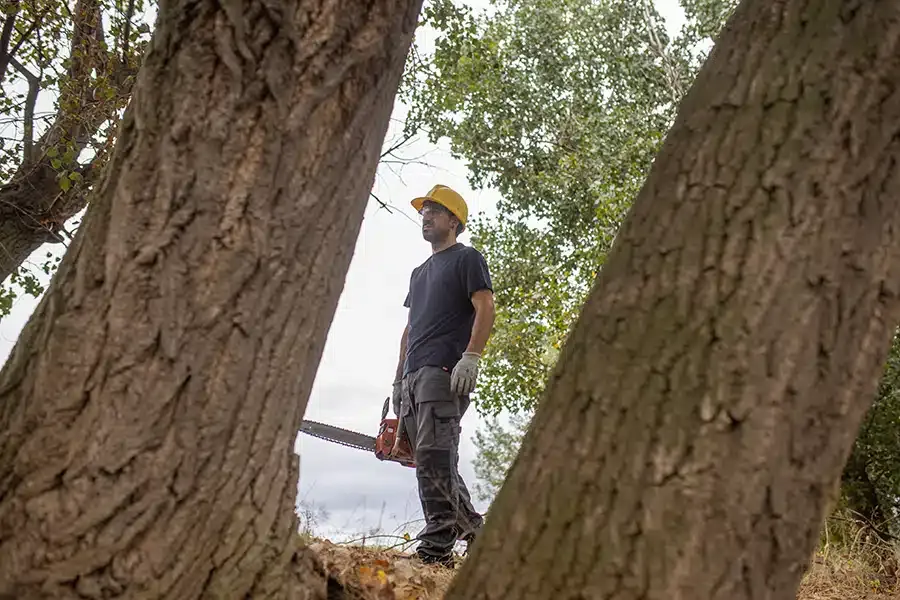Santa Clarita Tree Service
(661) 338-5661

Trees are a valuable part of your landscape, providing shade, beauty, and even increasing your property’s value. But not all trees can or should be saved. Sometimes, due to age, disease, structural damage, or safety concerns, tree removal becomes necessary.
Knowing the warning signs early can help prevent accidents, property damage, or the spread of disease to nearby trees.
While regular maintenance can extend a tree’s life, some trees reach a point where removal is the safest and most responsible choice. Here's how to recognize when a tree on your property might need to come down.
The Tree Is Dead or Dying
A dead or dying tree is a major safety hazard and should be removed promptly.
- No leaves during the growing season – If a tree doesn’t leaf out in spring or has large bare sections, it could be dead or in severe decline.
- Brittle or dry branches – Branches that snap easily and lack flexibility are a sign of poor health.
- Peeling or missing bark – This may indicate disease or that the tree has stopped receiving nutrients.
- No new growth – A lack of budding or foliage over time points to a non-recoverable tree.
Dead trees can fall unexpectedly, especially during storms, so it’s important not to ignore these signs.
The Tree Is Structurally Unsound
Even if a tree looks healthy, internal or root damage can make it unstable.
- Large cracks or splits in the trunk – These can signal deep structural issues that weaken the tree.
- Leaning significantly – A new or worsening lean often means the roots are compromised or shifting.
- Mushrooms at the base – Fungal growth around the roots or trunk base can indicate decay inside the tree.
- Exposed or damaged roots – If the roots are visible, severed, or rotting, the tree may not have enough support to remain upright.
Trees with internal or root instability can fall with little warning and should be assessed by a professional as soon as possible.
The Tree Has Extensive Disease or Pest Infestation
Sometimes, a diseased or infested tree can be treated, but in advanced cases, removal is the best option.
- Discolored or spotted leaves – Persistent issues with foliage can point to fungal infections or other diseases.
- Multiple dead limbs or thinning canopy – This could indicate that the tree is struggling to survive.
- Visible pests like beetles or borers – An active infestation can quickly destroy the tree from the inside out.
- Oozing sap or strange growths – These may be signs of bacterial infections or invasive fungi.
A severely infected tree can pose a risk to other healthy trees nearby, making removal necessary to protect your landscape.
The Tree Is Causing Property Damage or Obstruction
In some cases, a healthy tree still needs to be removed due to its location.
- Roots are damaging foundations or pipes – Aggressive root systems can crack driveways, sidewalks, or even the foundation of your home.
- Branches are interfering with power lines or roofs. Constant pruning may no longer be a safe or effective solution.
- The tree is blocking views or crowding other trees. Overcrowding can limit light, airflow, and space for other plants to grow.
- Obstructing driveways or walkways – Trees in high-traffic areas can pose a hazard if visibility or movement is impaired.
When a tree becomes more of a burden than a benefit, strategic removal may improve both safety and usability of your space.
The Tree Was Damaged in a Storm
Storms can leave even healthy trees in a dangerous condition.
- Split or hanging limbs – These can fall at any time, especially during the next weather event.
- Partially uprooted – If the tree is leaning or the soil is heaving around the base, it may be beyond saving.
- Lightning strikes – A lightning-damaged tree may suffer internal damage that's not immediately visible but leads to decline over time.
If a storm leaves your tree weakened or unstable, it’s important to have it inspected promptly to assess whether it can be salvaged or should be removed.
Trees are resilient, but they aren't immune to age, disease, or damage. Recognizing the signs that a tree needs to be removed can protect your home, family, and other trees in your yard.
If you notice any of these issues, it’s wise to consult a certified arborist.
With professional guidance, you can determine whether removal is the best course of action and ensure it’s done safely and responsibly.